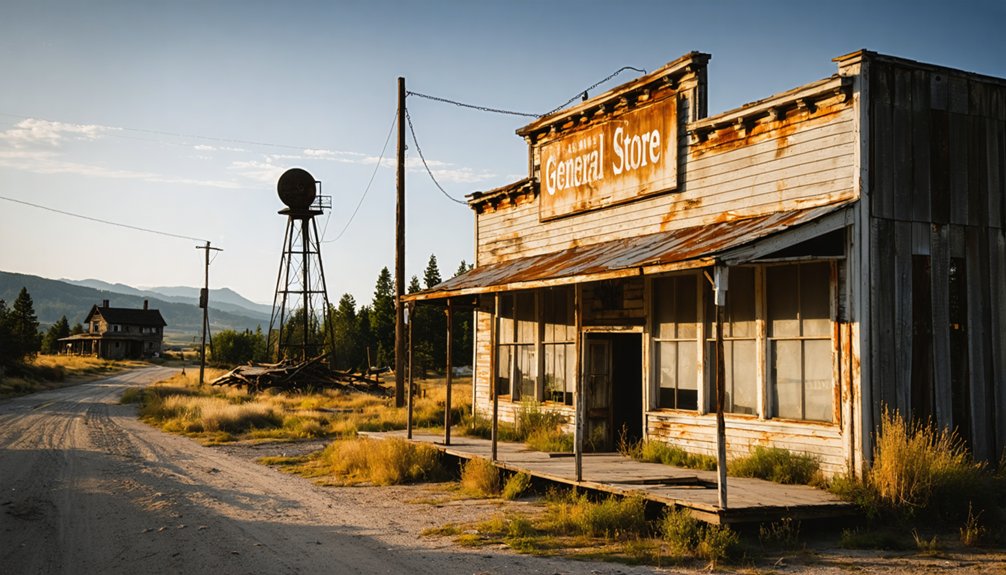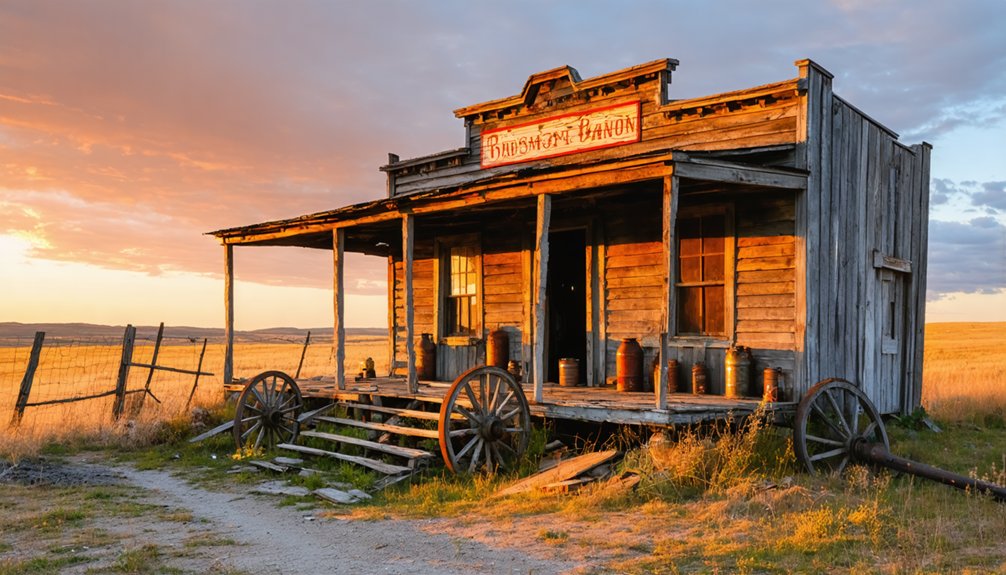You’ll find Cheyenne Falls among South Dakota’s most fascinating ghost towns, where an 1876 gold discovery transformed a remote Black Hills settlement into a thriving mining hub. At its peak, the town housed 10,000 residents, complete with saloons, dance halls, and the profitable Hidden Treasure Mine. Though abandoned by mid-20th century due to depleted mines and flooding damage, today’s ruins, hiking trails, and ghost tours offer glimpses into its Wild West legacy.
Key Takeaways
- Cheyenne Falls was a bustling mining town in southwestern South Dakota established in the 1800s following gold discoveries.
- The town reached its peak population of 10,000 during the height of mining operations, featuring saloons, shops, and diverse cultural activities.
- Mining decline, market price falls, and flooding damage led to widespread abandonment by the mid-20th century.
- Physical remnants include building foundations, sawmill ruins from 1952, and small cemeteries documenting the 1919 influenza epidemic.
- The ghost town now attracts thousands of tourists annually with ghost tours, hiking trails, and historical reenactments.
Origins and Early Settlement
While the Black Hills region was long inhabited by Native American tribes, particularly the Lakota Sioux, Cheyenne Falls emerged as a settlement in southwestern South Dakota during the late 1800s.
You’ll find that settler motivations centered primarily on the area’s rich mineral deposits and abundant timber resources, which promised lucrative opportunities for those willing to brave the harsh terrain.
The settlement’s strategic location near streams and waterfalls attracted prospectors and lumber workers who established basic structures, including cabins and general stores. Much like the Wild West era of neighboring Wyoming, the town faced its share of dangers and excitement during its early development.
Like the more than six hundred ghost towns recorded in the Black Hills region, Cheyenne Falls would eventually succumb to changing economic conditions.
Indigenous interactions played an essential role in early settlement patterns, as Native American knowledge helped newcomers navigate the challenging landscape.
While early explorers and fur traders had passed through the region previously, it wasn’t until the mining boom that permanent residents began establishing themselves in this rugged corner of the Black Hills.
Mining Operations and Economic Growth
After gold was discovered in 1876, the Black Hills Gold Mining Company emerged as one of Cheyenne Falls’ pioneering ventures, investing $25,000 to acquire the Hidden Treasure Mine. The operation initially yielded $20,000 in gold before legal disputes temporarily halted production. The Sioux Nation treaty of 1868 had previously protected these lands from mining operations.
You’ll find that mining technologies evolved rapidly during this period, shifting from basic placer mining to sophisticated hard rock operations using Blake Crushers and stamp mills. Legal battles and worker strikes, including the notable feud at Keets Mine, impacted mining operations across the region. The industry’s growth sparked significant economic diversification throughout the region, with mining camps spurring the development of supply networks between Cheyenne and Sidney.
While smaller mines eventually succumbed to rising costs and depleted resources, major operations like the nearby Homestake Mine continued producing, contributing roughly 10% of the world’s gold supply over 125 years of operation.
Life in a Black Hills Mining Town
Once gold was discovered in Cheyenne Falls, the social fabric of the town quickly evolved into a vibrant mosaic of miners, merchants, and service providers.
During the peak of mining activity in the Black Hills, population reached 10,000 as prospectors flooded the region.
The community dynamics reflected the cultural diversity of European immigrants, African Americans, and Chinese workers who established churches, schools, and fraternal organizations.
The discovery of placer gold deposits in the surrounding creeks drove the initial rush of miners to the area.
You’d find stark contrasts between the temporary tents of newly arrived prospectors and the wooden structures of established residents.
- After a grueling day in the dangerous mines, you could unwind at bustling saloons and dance halls.
- You’d face harsh living conditions with limited plumbing and frequent disease outbreaks.
- Your economic stability would depend on the unpredictable nature of mining success.
Living in Cheyenne Falls meant adapting to seasonal extremes while maneuvering social hierarchies between wealthy mine owners and laborers in this rapidly growing frontier town.
Transportation and Infrastructure
Before the arrival of the Union Pacific Railroad, transportation in and around Cheyenne Falls relied heavily on a network of freight trails and wagon roads that connected the bustling mining town to essential supply routes.
The Chamberlain Road served as a crucial artery for moving goods, with wagon trains hauling millions of pounds of freight during peak years of 1878-1879. Local trappers had established many of these routes during the fur trade expansion that began in 1743.
You’d find transportation networks expanding as bridges and ferries conquered major river crossings, particularly at the Belle Fourche River.
The railroad’s arrival transformed Cheyenne Falls’s infrastructure development, bringing Pullman cars and immigrant coaches filled with tourists, settlers, and miners.
Local stagecoach services like the Pioneer Stage Line bridged the gaps between railheads and mining camps, offering daily passenger service from 1876.
The Rise and Decline of Cheyenne Falls
The discovery of mineral deposits in the Black Hills region sparked Cheyenne Falls’ rapid transformation from untamed wilderness into a bustling mining town in the late 19th century.
You’ll find that during its peak period, the town supported several hundred residents with thriving businesses, social venues, and civic amenities built around its mining-based economy. Like many other towns in South Dakota, better road access eventually contributed to its decline. The area required extensive backcountry exploration to reach many of these historic mining settlements.
The town’s fortunes would ultimately fade by the mid-20th century as the mines depleted, market prices fell, and environmental challenges mounted, leading to widespread abandonment of the once-prosperous settlement.
Mining Boom Sparks Growth
Gold’s discovery in the Black Hills during Lieutenant Colonel George A. Custer’s 1874 expedition ignited a transformative gold rush that would reshape Cheyenne Falls.
You’d have witnessed prospectors flooding the area, staking claims along French Creek and Whitewood Creek while searching for the elusive Mother Lode. The Black Hills Gold Mining Company emerged as a pioneering force, investing $25,000 in the Hidden Treasure Mine.
- Innovative prospecting techniques evolved from simple placer mining to sophisticated hard-rock extraction.
- The first quartz crushing mill’s arrival in 1876 revolutionized ore processing capabilities.
- Chemical processes like cyanidation transformed low-grade ore into profitable ventures.
The boom’s impact rippled through the region as mining operations expanded, drawing investors and spurring rapid development.
Railways soon connected Cheyenne Falls to crucial supply chains, while successful ventures like the Homestake Mine near Lead demonstrated the region’s incredible potential.
Town’s Gradual Abandonment
While prosperity defined Cheyenne Falls during its mining heyday, economic turbulence struck the town hard by the early 1910s. You’d have witnessed the domino effect as mine closures triggered widespread economic migration, with miners and their families leaving to find work elsewhere.
Similar to the fate of Lake Pactola’s remains, flooding damage wreaked havoc on the town’s infrastructure. The exodus crippled local businesses that depended on the mining industry. When the railroad abandoned its routes through Cheyenne Falls, you’d have seen the town’s isolation deepen. The community decline accelerated as schools, churches, and shops shuttered their doors.
Environmental challenges, including contaminated mine tailings and flood damage, made any chance of revival unlikely. Those who remained faced deteriorating infrastructure and dwindling services, while younger generations sought opportunities in larger cities, leaving only ruins and memories of the once-thriving mining settlement.
Physical Remnants and Archaeological Discoveries
Located in the heart of South Dakota’s Black Hills, Cheyenne Falls exists today as a very small ghost town with limited physical remnants.
Archaeological techniques have revealed traces of foundations, scattered building materials, and ash heaps that hint at the town’s former layout. Through site preservation efforts, you’ll find transformed railroad grades now serving as hiking trails, showcasing the adaptive reuse of these historic corridors.
Modern archaeology unveils the ghostly footprints of foundations and debris, while old rail lines find new life as scenic hiking paths.
- Discover the haunting ruins of former houses and the foundations of the once-bustling sawmill that operated until 1952
- Explore small cemeteries that tell silent stories of the 1919 influenza epidemic and early settler families
- Walk along repurposed railroad grades where multiple lines once converged to support lumber and cattle industries
The site’s archaeological significance persists despite natural reclamation and flooding events that have altered many original structures.
Historical Tourism and Legacy Today

Today, Cheyenne Falls stands as a tribute to South Dakota’s rich mining heritage, drawing thousands of curious visitors each year to explore its historic remnants.
You’ll find a vibrant heritage tourism scene that connects you with the region’s boom-and-bust mining past through ghost tours, hiking trails, and storytelling events.
As part of the broader Black Hills ghost town network, including nearby Nahant and Dumont, Cheyenne Falls helps preserve the cultural identity of South Dakota’s pioneering spirit.
You can experience this history through guided tours, interpretive signs, and local museums.
Historical societies and volunteer groups actively maintain the site, while seasonal events and reenactments bring the town’s mining era to life.
Local authors and researchers continue documenting the town’s significance, ensuring its legacy endures for future generations.
Frequently Asked Questions
Are There Any Reported Ghost Sightings or Paranormal Activity in Cheyenne Falls?
Unlike other haunting hotspots that’ll send shivers down your spine, you won’t find documented ghost encounters or paranormal investigations in this location. Research shows no official reports of supernatural activity here.
What Valuable Personal Artifacts Have Been Discovered by Archaeologists at Cheyenne Falls?
You’ll find significant archaeologist findings at the site include obsidian blades, various chert tools, arrowheads, native pottery fragments, and bone artifacts showing evidence of prehistoric trade networks and settlements.
Was There Ever a Major Fire or Disaster in Cheyenne Falls?
While you might expect dramatic fire history in a ghost town, there’s no evidence of any major fires or disaster impact in historical records – economic decline and railroad changes caused its abandonment.
Which Prominent Historical Figures Visited or Stayed in Cheyenne Falls?
You’ll find limited records of specific historical visitors, though mining executives, railroad officials, and Eastern investors likely passed through during the boom years, while notable residents remain largely undocumented.
Did Native American Tribes Have Settlements Near Cheyenne Falls Before Mining Began?
Like rivers flowing through time, Cheyenne and Lakota tribes established settlements near these lands before mining began. You’ll find tribal history shows seasonal camps following bison herds and resource-rich waterways.
References
- https://www.sdpb.org/rural-life-and-history/2023-08-21/some-black-hills-ghost-towns-and-their-origins
- https://www.sdhspress.com/journal/south-dakota-history-2-2/some-black-hills-ghost-towns-and-their-origins/vol-02-no-2-some-black-hills-ghost-towns-and-their-origins.pdf
- https://freepages.history.rootsweb.com/~gtusa/usa/sd/blackhills.htm
- https://www.blackhillsbadlands.com/blog/post/old-west-legends-mines-ghost-towns-route-reimagined/
- https://travelwyoming.com/blog/stories/post/5-wyoming-ghost-towns-you-need-to-explore/
- https://www.geotab.com/ghost-towns/
- https://en.wikipedia.org/wiki/List_of_ghost_towns_in_South_Dakota
- https://usghostadventures.com/cheyenne-ghost-tour/
- https://www.onlyinyourstate.com/experiences/south-dakota/capa-ghost-town-sd
- https://www.cheyenne.org/blog/post/haunted-places-in-cheyenne/



